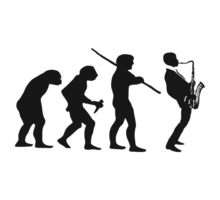In case you didn’t already notice, this is a blog, thus I’m going to try to use an infographic to communicate an idea. Read below the graphic for more information.
As a saxophone player I’ve transcribed many, many saxophone solos. When you’re starting to learn jazz, transcription is one of the first pieces of advice you’ll receive: “Just transcribe a bunch of solos!” says random Joe jazz mentor/teacher.
But why do we transcribe?
And what is the best process? It can be tedious, but is the payoff to build your vocabulary, give your ear and notation skills a good workout, emulate the sound/style of one of your idols, to just figure out what the hell somebody is playing? Yes to all these things, but I’d argue that the value of transcription evolves as you develop as an improviser.
In the early stages of your foray into jazz improvisation, you can use transcription as a tool for starting to make the connection between the chord changes and the note choices an improviser makes. Knowing to play a C-major scale over a Cmaj7 is one thing, but understanding the standard language over a c-major within the jazz idiom takes a lot of listening and transcription.
As you become more fluent in the language of jazz, you will begin to understand most of what you are listening to without even writing it down. They are playing a language that you have spent many hours studying. Just as you don’t need to open your Spanish-English dictionary to know how to place an order at a coffee shop in Peru after studying 8 years of Spanish, you will begin to hear most of the lines and harmonic choices made by jazz musicians in real time. At this point, I generally use transcription to decode somebody’s harmonic and melodic language. That can be either taking a single line, or in select cases an entire solo, and figuring out what they were playing.
Stick to your instrument?
Many improvisers stick to their own instruments, and for good reason. Say you’re a sax player. In the early stages of your development, you will get the most out of a sax transcription. Your aim should be to learn the solo exactly as it was originally played, every inflection and detail should be copied.
However, as you evolve, you are getting less value out of the instrument-specific aspect of transcription and can draw more from the theoretical side. Look to other instruments to expand your range.
Aaron Goldberg over “One Finger Snap”
In that spirit, here’s a transcription of Aaron Goldberg on his contrafact “Head Trip” of Herbie’s “One Finger Snap”.
Aaron Goldberg – Head Trip – C
Currently Listening To Bud Powell, Time Waits

